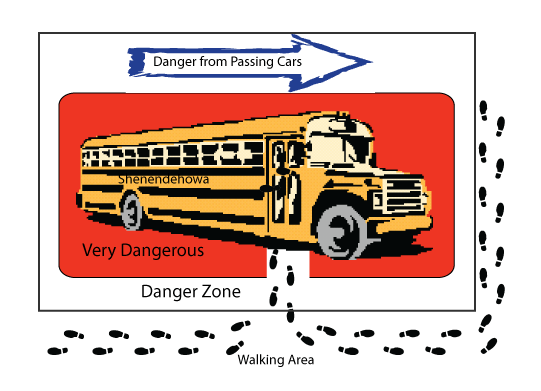Bus Safety
Students should arrive at the bus stop approximately 10 minutes early.
Students should wear a backpack rather than carry a tote bag, if possible, to keep hands and arms free. (If an item which is too large to fit in the backpack must be brought to school, please drive your child that day or make other arrangements for his/her safety and the safety of the others riding the bus.) Nothing should be dangling from students clothing or backpack (i.e. key changes, strings, etc.).
Good behavior is important to ensure a safe and pleasant ride for our students. Of course, kids will be active, particularly during the afternoon ride. However, they are expected to stay in the bus seats, speak in “inside” voices and listen for driver’s instructions (and only the driver’s instruction, particularly when crossing in front of t he bus).
Please teach your children to be careful in the danger zones. Ten feet around the perimeter of a bus is the danger zone. The most dangerous spots are in the front and back right corner. Please be aware:
Our drivers are trained to be aware of conditions along the route such as sudden thunderstorms or unusual occurrences in a neighborhood such as an unfamiliar car. However, it is still important to advise your children to go directly home or directly to their child care location.
Video cameras are used on our buses on a rotating basis to help monitor activity on the bus and also to reinforce acceptable behavior.
Please use parking areas, not bus ports for drop off and pick up of students. Bus ports are for buses only.
Speed limit is 15 m.p.h. on school property (including the entire main campus), New York State law applies: Do not pass any bus with its red lights flashing.
At each stop, the driver will carefully observe the number of students crossing and account for all these students. The driver shall not open the door of the school bus until she/he observes that the road is clear and that no danger exists.
The driver – when receiving or discharging students who must cross a street – shall instruct the students to:
- Look left and right before stepping off the bus.
- Walk at least 10 feet in front of the bus within the vision of the driver (if the child can’t see the driver, then the driver cannot see the child).
- Wait for the driver to signal before crossing.
- Before passing the bus, stop and look left and right, then proceed across the street.
- If driver blows the horn, student should return to the side of the road.
- At no time should students return to the bus after crossing.
Crossing Rules
Crossing the highway safely is vitally important. All students must follow the bus driver’s instructions when crossing a road. The driver will direct students crossing before releasing non-crossers.
At a stop where there are children who have to cross in front of the bus (crossers) and children who do not (non-crossers), the driver will instruct the crossers to walk forward of the bus until they can see the driver’s instructions. Students should look at the driver and wait for the driver’s signal, stop at the side of the bus, and look both ways before continuing across the highway. If warned by the driver, (by sounding the horn or speaking through the outside PA system) the student should return to the starting point on the safe side of the street.
The non-crossers will then be allowed to leave the bus. They should walk away from the bus and out of the danger zone. Children will not be permitted to cross in the back of the bus. Children should be instructed not to go to their mailboxes or to linger near the stop, because the driver has been instructed and State law requires the driver not to move the bus if there are students within fifteen (15) feet of the bus.
Bus Danger Zone
Student Conduct on the School Bus
It is important that all children behave properly and safely on the school bus and for parents to discuss safety and behavior with their children. The district’s Code of Conduct for the Maintenance of Order on School Property (the Code) includes a section on busing that should be reviewed by all parents. It prohibits food and drinks on the bus, smoking, throwing objects at or out of the bus, injury to another student, physical damage to a bus, insubordination or leaving the bus through an emergency door/window in a non-emergency, and many other busing safety/discipline issues. The Code is available at the district office, each school and at Shenet.org.
Video cameras are sometimes used to monitor student behavior on school vehicles. The intended use of the recordings obtained from using such cameras shall be used to help in determining strategies for improving student discipline and as evidence of misconduct.
Seat Belts/Bus Drills
Students are trained to properly use seat belts. School bus drivers will instruct students on the proper use of seat belts during the three (3) bus drills scheduled during the school year.Seat Belts
New York State law requires drills which include practice and instruction in the location, use, and operation of the emergency door(s) and windows as a means of escape in case of a fire or accident and location of the first aid kit and fire extinguisher. Drills shall include instruction in safe boarding and exiting procedures with specific emphasis on when and how to approach, board, disembark, and move away from the bus after disembarking. Drills shall also include instruction in the importance of orderly conduct by all passengers with specific emphasis given to student discipline rules.



